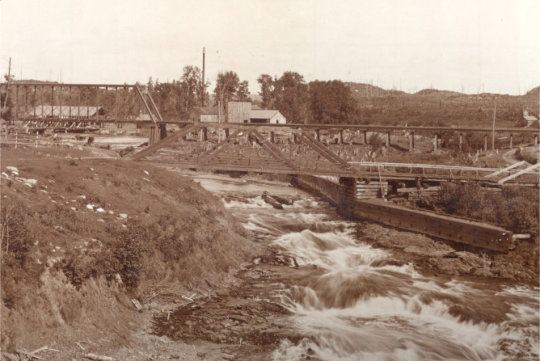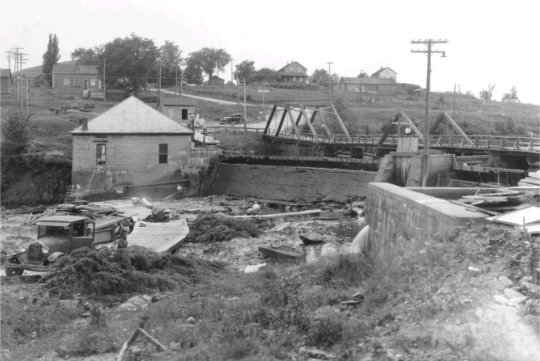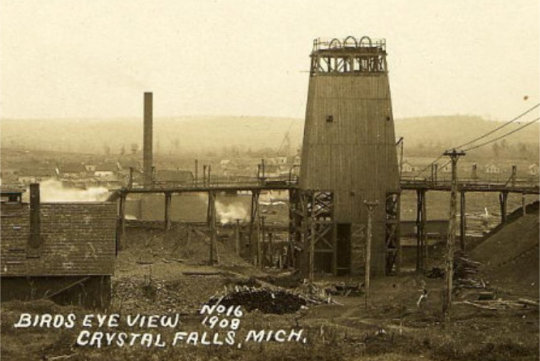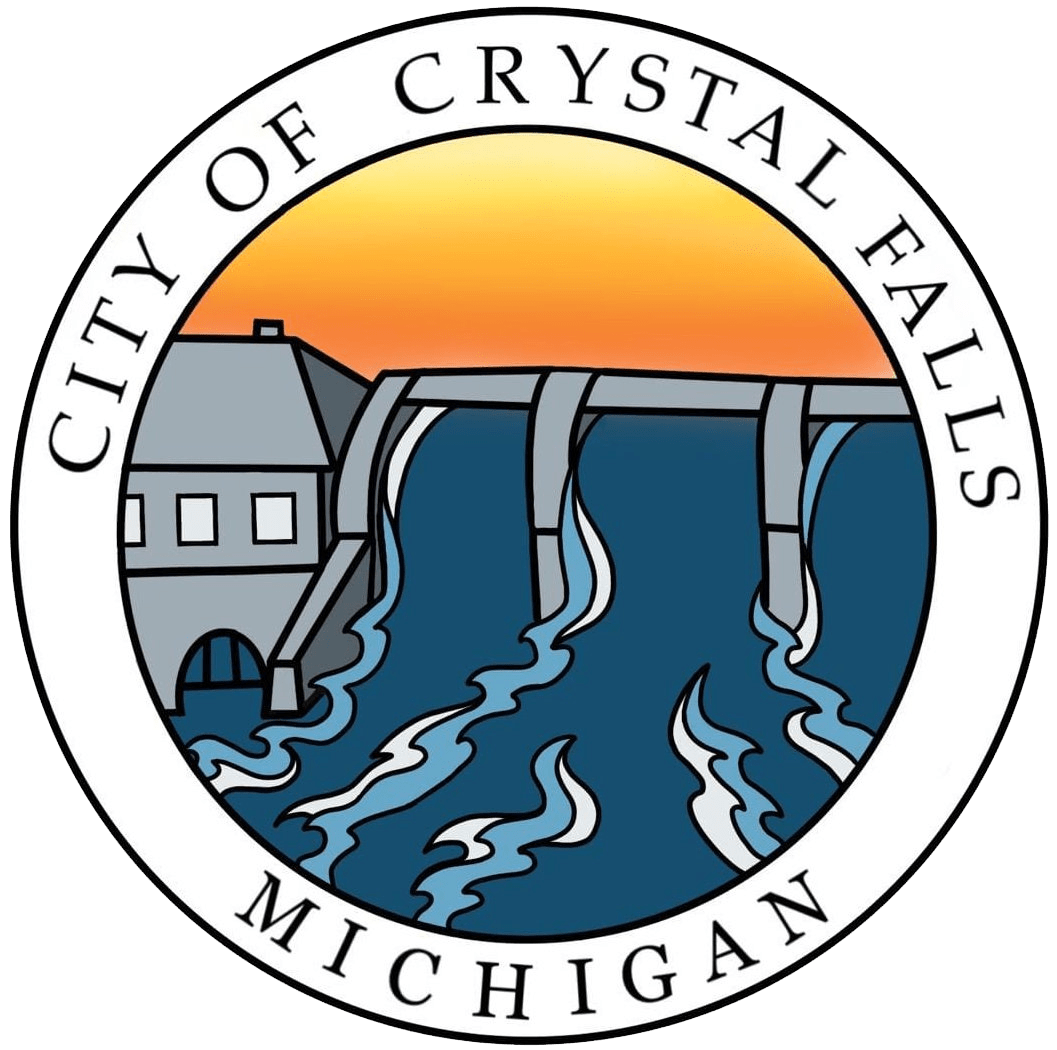COMMUNITY
History
Community Profile
The City of Crystal Falls, born of the early iron mining and timber explorations in the southwest of Michigan’s Upper Peninsula, sprawls leisurely on hilly terrain extending east and west from the banks of the Paint River. It is a city that, in growing from its first settler’s shacks to a picturesque residential community, went into partnership with nature in preserving a natural setting for itself. Most impressive is the Iron County Court House that graces the west end of Superior Avenue, the main business section of the City.
The City owns and operates its own hydro-electric plant which provides a portion of the electricity used by the residents, keeping electric rates significantly lower than most communities of today. The City has also operated it own cable TV system since 1958 with recent upgrades to allow expansion.
Runkle Lake Park, located on beautiful Runkle Lake, offers a sandy beach and playground, camping and picnic areas, good fishing, and lots of PEACE AND QUIET.
Evergreen Memorial Cemetery is a site of great pride in our community. The well kept grounds provide a beautiful and peaceful final resting place.
Check out the Iron County Heritage Trail website at Ironheritage.org
PROFILE:
Form of Government: Council/Manager
Population: 1791 (2000 Census)
Males = 849
Females = 942
under 5 years = 77
5 – 9 years = 99
10 – 14 years = 122
15 – 19 years = 144
20 – 24 years = 66
25 – 34 years = 127
35 – 44 years = 261
45 – 54 years = 221
55 – 59 years = 79
60 – 64 years = 81
65 – 74 years = 198
75 – 84 years = 208
85 years and over = 108
Racial/Ethnic Population Breakdown:
White (non-hispanic) …..98%
Black…………………………..Less than 1%
Hispanic………………………Less than 1%
Asian…………………………..Less than 1%
Native American……………Less than 1%
Workforce Distribution by Industry:
Manufacturing……………………….15%
Trade (retail/wholesale)………….20%
Agriculture (including logging)…20%
Services…………………………………45%
Households:
Occupied Households…………..795
Vacant Households………………118
Seasonal Households……………32
Average household size………..2.13
Average family size……………..2.78
The Falls
Visitors to Crystal Falls often ask “where are the crystal falls?” In fact, the only time this area looks like a falls at all is in the spring during the spring run off. With the building of the power plant in the 1890’s the water from the paint river was backed up into a reservoir and rerouted through the turbines to light up the city.
The first picture is how the falls looked in the early 1880’s prior to the building of the municipal power plant. The paint river spilled over the rocks under a bridge. in the background is a railroad bridge, long since removed, however, the abutments are still visible in the area upstream from the city power plant.
The picture below is a photo of the building of the dam that now backs up the reservoir behind the power plant. The power plant itself is the building directly behind the 1929 model “A” truck. This photo was taken august 6, 1931.
To this day, the city owns and operates the power plant which generates enough electricity for about 1/3 the demand of the city. The balance of the electricity needed is purchased from Wisconsin Electric Power Co. The residents of the area enjoy very reasonable electric rates due to the operation of this power plant.



Logging
Logging has been a part of the Crystal Falls area from the beginning of the settlement. The Paint, Net, Fence, Brule, Deer, Hemlock, and Michigamme Rivers served as highways to transport the logs out of the woods to sawmill landings. The logs were moved to the rivers from the wood lands by horse drawn sleighs in the early 1900’s.
The picture is of an early sawmill once located on the north bank of the Paint River just across from the site of the present day power plant. The logs were “driven” down the river to the sawmill by “log sailors” who repeatedly risked their lives to move the product to the sawmills.
Today, modern machinery has made the practice of logging much more efficient and safe. The City of Crystal Falls experiences daily the transport of many tons of trees over the main highways that cut through the town as logging trucks, many with trailers behind, haul their product for processing to paper and sawmills in nearby towns.
Mining
In the early 1880’s Crystal Falls was one of the main iron mining towns in the Upper Peninsula. Solomon D. Hollister, a native of Sparta, Wisconsin made his way to the Crystal Falls area in 1880. He became associated with George Runkel, who was born in Germany, and also came to the area in 1880. Together they discovered that there was much iron ore to be mined here, and formed the Crystal Falls Iron Company. This company made the greatest single contribution toward the development of the district.

In the early 1880’s Crystal Falls was one of the main iron mining towns in the Upper Peninsula. Solomon D. Hollister, a native of Sparta, Wisconsin made his way to the Crystal Falls area in 1880. He became associated with George Runkel, who was born in Germany, and also came to the area in 1880. Together they discovered that there was much iron ore to be mined here, and formed the Crystal Falls Iron Company. This company made the greatest single contribution toward the development of the district.
In the spring of 1881, Hollister and Runkel were convinced they had discovered a new iron range. The Chicago and North-Western Railroad was completed in Crystal Falls in June of 1882, paving the way for transporting the many tons of ore to the ports on the Great Lakes. There wee six active mines in the area when the railroad was completed and a total of 42,111 tons or ore was shipped the first year.
The first mine in the Iron County area was the Fairbanks or Paint River mine in Crystal Falls. Opened in 1882 and operating until 1913 it shipped a total of 382,089 tons of ore. The Great Western Mine, the deepest in the area at a depth of 700 feet when it opened in 1882, employed about 130 men. By the time it closed in 1910 it had reached a depth of 1,250 feet and shipped 2,296,739 tons of ore. The Crystal Falls Mine opened in 1882, operated until 1913 and shipped a total of 1,744,015 tons of ore. The Youngstown Mine opened in 1882, operated until 1897 and shipped 151,425 tons of ore. In 1949 it was reopened along with the Bristol Mine as the Bristol- Youngstown Mine with shipments in 1950 that amounted to 105,018 tons. The Bristol Mine opened in 1892. In its lifetime, it shipped 8,726,097 tons of iron ore. Sinking down to a depth of 1,525 feet, it was mined by shrinkage and sub-level stopping methods. It was the last operating mine in Crystal Falls, closing in 1969. The Dunn Mine, also one of the larger producers, opened in 1887 and operated through 1915. It shipped a total of 2,208,511 tons of ore. The Tobin Mine opened in 1901, reached a depth of 1,783 feet, shipped 4,630,052 tons of ore, and closed in 1958. Other mines in the Crystal Falls area included: Ravenna-Prickett, Lamont, Lincoln, Hagerman, Hilltop, Victoria, Hollister, Armenia, McDonald, Lee Peck, Cayia, Hope, Kimball, Odgers, Genesee, Columbia, Monongahela, Carpenter, Lawrence, Richards, and the Fortune Lake Mines.
Miners received from $2.00 to $2.25 per ten hour day in the 1880’s. They would work one week of days and one week of nights alternately. Contract miners received $2.50 to $3.50 a day, while surface laborers received $1.70 to $2.00 a day.
The conditions in the mines were poor and unsafe and many lives were lost each year. The only compensation paid to the widows and children were the funeral expenses of the dead miner and one or two month’s pay. When a miner was killed in an accident, the miners would not enter a mine until the body of their comrade was interred, thereby stopping all operations at the mines for a day or two and causing considerable loss to the mining companies. On September 28, 1893, the Mansfield Mine along the nearby Michigamme River, caved in, killing 27 miners. Sixteen miners died in the Porter Mine cave in on February 21, 1918. The main concern of the mining companies was to get the ore out, no matter what the risk.
Stories told by the old miners, the many open pits, test pits, and stock piles scattered across the area are all that is left to remind us of the mining industry that caused the founding and growth of the Crystal Falls area.
